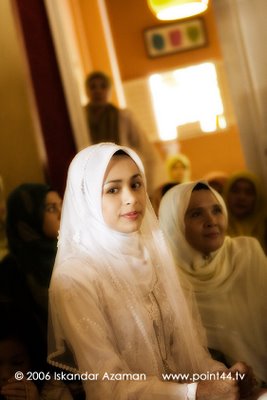 This photo on the left is from a recent wedding I did. It was my cousin's wedding actually. It was quite a challenge since I couldn't bounce my Lightsphere2 anywhere due to the wooden ceiling and the coloured walls. In the end I shot several test shots and decided to up the compensation of the flash for most of the shots. However, I got lucky with this shot. The positioning of the bride was perfect as a stream of light from the doorway just happened to light her up with such soft light. I shot this with a Canon 20D at 1/60 f2.8 and ISO800. I think the lens used was a 24-70L at 70mm. I didn't use flash on this shot.
This photo on the left is from a recent wedding I did. It was my cousin's wedding actually. It was quite a challenge since I couldn't bounce my Lightsphere2 anywhere due to the wooden ceiling and the coloured walls. In the end I shot several test shots and decided to up the compensation of the flash for most of the shots. However, I got lucky with this shot. The positioning of the bride was perfect as a stream of light from the doorway just happened to light her up with such soft light. I shot this with a Canon 20D at 1/60 f2.8 and ISO800. I think the lens used was a 24-70L at 70mm. I didn't use flash on this shot.What I like about the shot is that she took a natural glance at me when I clicked the shutter. With the light streaming in and isolating her face it just made the perfect picture for me. Another thing that I felt added to the picture was the presence of the character standing at the back of the picture. This gives a sense of occasion where everyone is trying to catch a piece of the action.
I have been quite surprised by the high ISO performance of the 20D. At ISO 800 there have been no problems with me enlarging this shot up to 8x10. I'm sure I can go bigger though since there's very little noise in the print. Maybe from now on I'll use ISO800 as standard at weddings and go to 1600 when I'm a little brave and want to experiment. Since not many large prints are made for weddings I think it's very possible to go that high.
However, I shoot 100% RAW. This has helped a lot when it comes to noise. I can't remember the last time I used the JPEG setting. There is so much advantage of shooting RAW that the disadvantage of having to buy more cards is negligible. Since memory prices are dropping everyday it has become easier for me as well. Maybe in future posts I'll say some stuff about RAW.
This shot has been photoshopped. I used an action to achieve the ethereal or glowing effect. It's called the midnight sepia action available free at ATNCENTRAL. Nothing else was done to the photo. I know I shouldn't use effects too much but this particular action gives such a nice feeling to the photo. I just love this action so much that I've used it on a few shots for this particular wedding. I tried it on a picture from another wedding and it didn't work at all. Just made the photos even worse. Just shows that a little goes a long way. You can't use one thing for everything.
Personally, I think the picture was nice on its own without any photoshopping done to it but in this instance I think it added to the picture without changing the picture much. There's no reason you can't photoshop images and there's no rule that says you can't. People still shoot black & white images and real life isn't black & white. If you want to photoshop, then do so. My motto for almost everything is 'Real Men Do Whatever the Hell They Want'.
Anyway, to end the post I'd like to share a personal tip for shooting indoors. If you're using flash on a current modern SLR with ETTL2 (or i-TTL if you're using Nikon) try using the manual setting. I can't explain to you the whole ETTL thing in a blog but you could go to the greatest Canon flash resource centre here. Basically, expose for the ambient/background and the flash will do the rest for the subject. If you're shooting in a dark area then drag the shutter. Set the shutter speed to the lowest speed you can handhold and set the aperture accordingly.This will result in a better overall exposure where you get some ambient light which will also get rid of the cave look where the background is all black. Using this technique as opposed to using Aperture Priority prevents the shutter speed going down so much that there will be evidence of blurring. Aperture Priority has it's place and I use it always when I'm outdoors and there's enough light, but indoors it's 100% manual.

0 Comments:
Post a Comment
<< Home